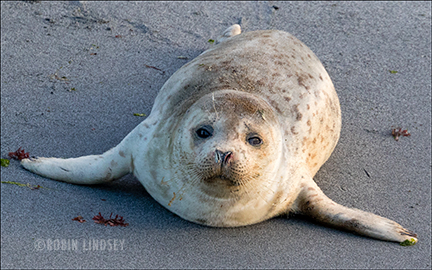Seafoam
Volunteers spend long hours protecting Seafoam
May/10/17 07:33 AM

On Friday afternoon, First Responders David and Eilene were out for a walk along West Seattle’s Alki Trail and noticed a group of bystanders gathered on the seawall above a small pocket beach and common spot for seal pups to come ashore. Thankfully, barricades and tape were stashed at the site. They quickly asked the crowd to step back and cordoned off the small area. Volunteers were summoned and the pup was able to rest on the beach until very late that night, gone shortly after midnight.
This weaner, nicknamed Seafoam, looked quite typical for the majority of seals born last year and now almost a year old: thin and with some respiratory issues (nasal and eye discharge and some coughing), after surviving a very long, wet and cold winter. The good news is that a milder spring brings a more bountiful food source to Puget Sound and lungworm infections, if not too serious an infestation, can sometimes wane.
These older weaners will soon be molting, afterwards sporting a brand new, silky coat. These days, the coats become brownish, scruffy and lackluster in the pre-molt and then it’s out with the old, gradually filled in with new shiny fur and well-defined markings. Weaners/yearlings are the first seals to molt. Adults in Central and South Puget Sound do so after breeding in the summer and early fall. Fur does not provide warmth for harbor seals, who instead depend on a thick layer of blubber fat for insulation energy.
Early Saturday morning, Seafoam crawled onshore again, but this time further east, around the bend on a little strip of beach in Elliott Bay. Staying until high tide erased the beach and water rushed over him, the seal took off and headed north. Gathering up cones and tape, volunteers walked along the seawall, following Seafoam as he traversed back to his prior evening’s resting spot.
Once again, volunteers taped of the grassy landing above the seal and closed access to the beach steps. Families, joggers, bikers and walkers all paused to talk to volunteers and get a great, close-up view of the sleepy seal, trying to snooze in the midst of a noisy whirl of urban activity. Many inquired if it was seal pup Taffy, now in rehab at PAWS Wildlife Center. Seafoam rested until 8:30pm before returning to the dark waters of the Sound.
Around 8am Sunday, the hotline received a report of a pup on the west side, below Alki Avenue’s sea wall. When First Responder Robin arrived she could see the seal’s tracks in the sand, leading from the seawall to the lapping water’s edge - and human footprints leading up to and across to the resting site. There was no seal and no person. She stopped a young couple walking by and asked if they had seen the seal. They stated that a woman had been down on the beach, too close to the seal and taking cell phone photos. Despite their warnings that she needed to stay back, she scared him back into the water.
Seafoam showed up less than an hour later on the opposite side of the point, with a repeat performance of the day before: sleeping at the Elliott Bay location until high tide and then swimming back to his second preferred location at Duwamish Head. Because it was a beautiful day, there were people on the pocket beach, but they graciously vacated the area to allow the determined little seal with the big, soulful eyes some additional rest.
Volunteers protected Seafoam until after 9pm, when he finally flip-flopped across a very long stretch of sand and disappeared into the Sound. He has not been sighted since.
Thanks to the first responders and dedicated volunteers who spent three long days - and windy and cold evenings - looking after Seafoam. They spoke with hundreds of people who stopped by the two locations to ooh and ahh and learn about seal behavior and biology and the many struggles that weaner seals face their first year of life.







